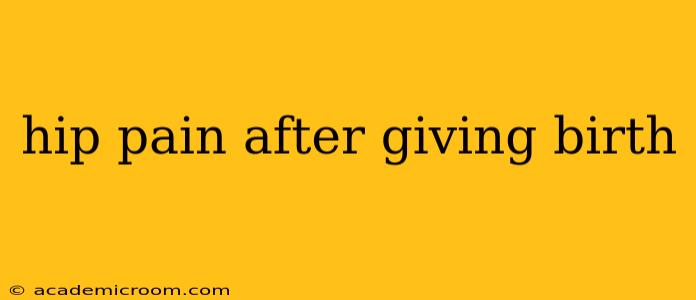Congratulations on your new arrival! The joy of childbirth is often overshadowed by various physical challenges, and hip pain is a surprisingly common one. Many new mothers experience discomfort in their hips in the postpartum period, impacting their ability to care for their baby and enjoy this special time. This comprehensive guide will explore the causes, treatment options, and preventative measures for hip pain after giving birth.
What Causes Hip Pain After Childbirth?
Several factors contribute to postpartum hip pain. Understanding these causes is crucial for effective management.
Hormonal Changes:
Pregnancy triggers a surge in relaxin, a hormone that softens ligaments and prepares the body for childbirth. While beneficial for delivery, this hormonal shift can also loosen the ligaments in your hips, making them more susceptible to instability and pain. This instability can lead to pain, especially with weight-bearing activities.
Pelvic Instability:
The relaxin surge mentioned above directly impacts pelvic stability. The ligaments supporting the sacroiliac (SI) joints and pubic symphysis can become excessively lax, resulting in pain and discomfort in the hips and lower back. This is often exacerbated by the added weight of pregnancy and the physical strain of labor and delivery.
Muscle Weakness:
Pregnancy and childbirth significantly impact core strength. Weakened abdominal and pelvic floor muscles can put extra strain on the hips, leading to pain and discomfort. This weakness can also contribute to poor posture, further exacerbating hip problems.
Postural Changes:
Carrying extra weight during pregnancy and the subsequent changes in posture can strain the hip joints and surrounding muscles. The body adapts to accommodate the growing baby, often leading to imbalances and pain.
Injury During Labor and Delivery:
In some cases, hip pain can be directly related to injuries sustained during labor and delivery, such as stretching or tearing of ligaments. While less common, this should be considered a potential cause.
Other Contributing Factors:
- Previous hip injuries: Existing hip conditions may be exacerbated by the physical changes of pregnancy and childbirth.
- Obesity: Increased weight places greater stress on the hip joints.
- Lack of physical activity: A sedentary lifestyle can contribute to muscle weakness and hip pain.
How is Hip Pain After Childbirth Treated?
Treatment options vary depending on the severity and cause of the pain. Many women find relief through conservative methods, while others may require more intensive interventions.
Conservative Treatments:
- Rest and Ice: Resting the affected area and applying ice packs can reduce inflammation and pain.
- Over-the-counter pain relievers: Ibuprofen or acetaminophen can provide temporary pain relief. Always consult your doctor before taking any medication, especially while breastfeeding.
- Physical Therapy: This is often a cornerstone of treatment. Physical therapists can help strengthen weakened muscles, improve flexibility, and teach proper posture and body mechanics to reduce strain on the hips. They may also use manual therapy techniques to address joint mobility restrictions.
- Pelvic Support Belt: A supportive belt can help stabilize the pelvis and reduce pain.
- Gentle Exercise: Low-impact exercises like walking and swimming can improve strength and flexibility without putting undue stress on the hips.
More Intensive Interventions:
In some cases, conservative treatments may not be enough. More intensive interventions might include:
- Corticosteroid Injections: These injections can reduce inflammation in the hip joint.
- Referral to a Specialist: If pain persists despite conservative treatment, a referral to an orthopedist or physiatrist may be necessary. They can evaluate the condition and recommend further treatment, which may include more advanced interventions.
How Can I Prevent Hip Pain After Giving Birth?
Prevention is always better than cure. Here are some strategies to reduce your risk of developing hip pain after childbirth:
- Maintain a healthy weight: Avoid excessive weight gain during pregnancy.
- Engage in regular exercise: Pre-pregnancy, focus on exercises that strengthen your core muscles, pelvic floor muscles, and hip muscles.
- Practice good posture: Maintain good posture throughout pregnancy and postpartum.
- Listen to your body: Rest when you need to and avoid activities that cause pain.
- Pelvic Floor Exercises (Kegels): Begin Kegel exercises during pregnancy and continue postpartum to strengthen pelvic floor muscles.
- Postnatal Physical Therapy: Consider attending postnatal physical therapy sessions, even if you don't experience pain. This can help prevent future problems.
When Should I See a Doctor About My Postpartum Hip Pain?
While some mild discomfort is common, you should consult your doctor if:
- Your pain is severe or persistent.
- You have difficulty walking or moving your hip.
- You experience numbness or tingling in your legs.
- Your pain is accompanied by fever or other symptoms of infection.
Postpartum hip pain can significantly impact a new mother's well-being. By understanding the causes, treatment options, and preventative measures, you can effectively manage your pain and enjoy this precious time with your baby. Remember to consult your healthcare provider for personalized advice and treatment.
